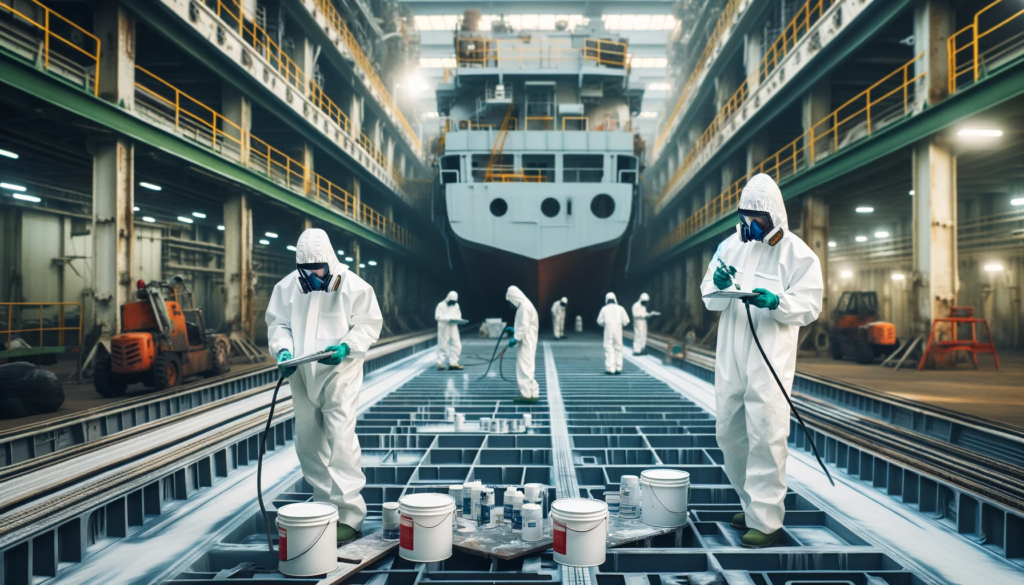Industrial painting, a distinct and essential discipline within the realm of industrial operations, straddles the line between science and art. Unlike commercial interior painting, which primarily seeks to enhance aesthetics, industrial painting is deeply rooted in functionality and durability.
This introduction seeks to illuminate the unique aspects of industrial painting, showcasing how it diverges from traditional painting methods in both purpose and application. We will explore the genesis of industrial painting, tracing its evolution alongside industrial advancements and its critical role in addressing the specific needs of industrial structures and equipment.
By searching through into the diverse functions it serves – from protection against extreme environmental conditions to ensuring operational efficiency – this overview aims to provide a comprehensive understanding of the significance and complexities of industrial painting in the modern industrial landscape.

Introduction to Industrial Painting
Industrial painting, a specialized field at the crossroads of science and art, diverges significantly from traditional painting practices. This distinction lies not only in the techniques and materials used but also in the purpose and environments where it is applied.
Originating from a rich historical context, industrial painting has evolved to meet the growing demands of modern industry, adapting to technological advancements and changing industrial needs.
Unlike regular painting, which primarily focuses on aesthetic appeal and surface protection, industrial painting serves a more functional role. It caters to the unique requirements of industrial structures and equipment, providing durability, protection, and efficiency under extreme conditions.
Functional Aspects of Industrial Painting
At its core, industrial painting serves several key functional purposes that are critical in industrial settings. One of the primary roles of this specialized painting is corrosion prevention. By applying scientifically formulated coatings, industrial painting protects metal structures and equipment from the debilitating effects of rust and chemical exposure, thereby prolonging their life and maintaining their structural integrity.
Another vital aspect is fireproofing. Certain industrial paint formulations provide a protective barrier that significantly reduces the risk of fire damage, making them indispensable in high-risk environments. Additionally, industrial painting plays a crucial role in enhancing energy efficiency and heat reflection.
Specialized reflective coatings are used to minimize heat absorption in buildings and machinery, leading to improved energy efficiency and reduced operational costs. These functional attributes underscore the importance of industrial painting not just as a means of surface treatment, but as a critical component in ensuring safety, longevity, and efficiency in industrial applications.
Practical Applications in Industrial Settings
Industrial painting finds its application in a lot of settings, each showcasing its indispensable value. In the manufacturing sector, for instance, it is utilized for coating machinery and assembly lines, ensuring longevity and resistance to wear and tear. This application not only preserves the equipment but also maintains a safe working environment by preventing rust-induced failures.
In the realm of heavy industries such as oil and gas, marine, and mining, industrial painting plays a pivotal role in safeguarding infrastructure against harsh environmental conditions like extreme temperatures, saltwater corrosion, and chemical exposure. Notably, in the construction of bridges, pipelines, and storage tanks, these protective coatings are vital for structural integrity and safety.
Another significant application is in the energy sector, particularly in solar and wind farms, where coatings are used to protect and optimize the performance of equipment. These practical examples demonstrate the versatility and necessity of industrial painting in various industries, highlighting its role in not only protecting assets but also in ensuring operational efficiency and safety.

The Importance of Professional Expertise
The success of industrial painting projects hinges significantly on the expertise of the professionals involved. Selecting the right type of paint and application method requires a deep understanding of the materials, environmental factors, and the specific demands of the industrial setting.
Professionals in this field not only need to be well-versed in the latest technological advancements in paint formulations but also in the application techniques that ensure durability and effectiveness. The expertise extends beyond mere application; it involves a comprehensive assessment of the environment, understanding the chemical and physical stressors that the surfaces will encounter, and choosing a solution that offers the best protection. This level of professional insight is crucial in preventing costly maintenance issues and ensuring the longevity of the coating.
Furthermore, adherence to safety and environmental regulations is paramount, and skilled professionals are essential for ensuring compliance. Their knowledge and experience play a pivotal role in executing projects that meet industry standards, safeguard assets, and protect the wellbeing of workers and the environment.
Conclusion
In conclusion, industrial painting stands as a cornerstone in the maintenance and preservation of industrial assets, transcending its role as a mere application of color. This specialized field, interweaving the precision of science with the practicality of engineering, plays a pivotal role in ensuring the longevity, safety, and efficiency of industrial infrastructure and equipment.
From safeguarding against corrosion and fire to enhancing energy efficiency, industrial painting addresses the multifaceted challenges of harsh industrial environments. The diversity of its applications across various sectors—from manufacturing and heavy industry to energy production—underscores its indispensable value in the industrial world.
Moreover, the importance of professional expertise in this field cannot be overstated, as it ensures the correct application of these sophisticated coatings, adherence to stringent safety standards, and compliance with environmental regulations.
As industries continue to evolve and face new challenges, the field of industrial painting will undoubtedly adapt and advance, reinforcing its critical role in the sustainable growth and maintenance of industrial operations. This exploration of industrial painting highlights not only its functional importance but also its contribution to the broader objectives of industrial innovation and environmental stewardship.